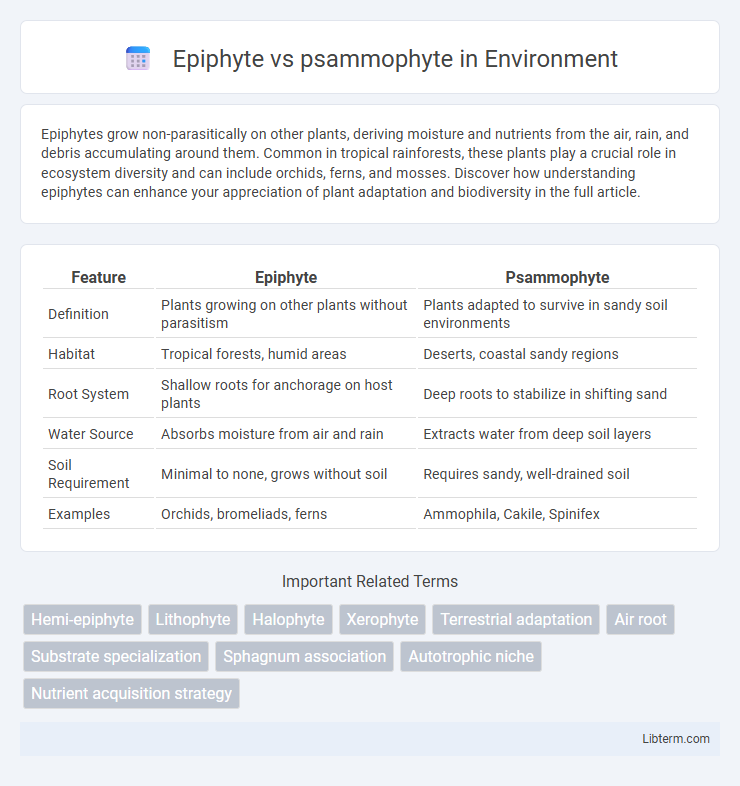Epiphytes grow non-parasitically on other plants, deriving moisture and nutrients from the air, rain, and debris accumulating around them. Common in tropical rainforests, these plants play a crucial role in ecosystem diversity and can include orchids, ferns, and mosses. Discover how understanding epiphytes can enhance your appreciation of plant adaptation and biodiversity in the full article.
Table of Comparison
| Feature | Epiphyte | Psammophyte |
|---|---|---|
| Definition | Plants growing on other plants without parasitism | Plants adapted to survive in sandy soil environments |
| Habitat | Tropical forests, humid areas | Deserts, coastal sandy regions |
| Root System | Shallow roots for anchorage on host plants | Deep roots to stabilize in shifting sand |
| Water Source | Absorbs moisture from air and rain | Extracts water from deep soil layers |
| Soil Requirement | Minimal to none, grows without soil | Requires sandy, well-drained soil |
| Examples | Orchids, bromeliads, ferns | Ammophila, Cakile, Spinifex |
Introduction to Epiphytes and Psammophytes
Epiphytes are plants that grow non-parasitically upon other plants, deriving moisture and nutrients from the air, rain, and debris accumulating around them, commonly found in tropical rainforests and cloud forests. Psammophytes are specialized plants adapted to thrive in sandy soils of arid and semi-arid environments, exhibiting drought tolerance and mechanisms for anchoring in loose substrates. The contrasting ecological niches of epiphytes and psammophytes highlight evolutionary adaptations to nutrient-poor habitats: epiphytes optimize aerial nutrient absorption while psammophytes develop root structures for stability and water retention.
Defining Epiphyte: Features and Adaptations
Epiphytes are plants that grow non-parasitically on other plants, primarily trees, obtaining moisture and nutrients from the air, rain, and debris rather than soil. These plants exhibit specialized adaptations such as aerial roots, waxy leaves to reduce water loss, and the ability to capture nutrients from organic matter in their canopy habitats. Unlike psammophytes that thrive in sandy, nutrient-poor soils, epiphytes rely on structural support and unique water absorption mechanisms to survive in forest canopies.
Defining Psammophyte: Features and Adaptations
Psammophytes are specialized plants adapted to thrive in sandy, nutrient-poor soils, commonly found in desert and coastal dune environments. These plants exhibit features such as deep root systems for water absorption, tolerance to high salinity, and leaves with waxy coatings or reduced surface area to minimize water loss. Unlike epiphytes, which grow on other plants for support, psammophytes root directly in sand, adapting to extreme conditions with traits that promote survival in unstable and arid habitats.
Key Ecological Differences
Epiphytes primarily grow on other plants, deriving moisture and nutrients from the air, rain, and debris, while psammophytes are adapted to sandy soils, often exhibiting deep root systems to access water and stabilize loose substrates. Epiphytes contribute to canopy biodiversity and microhabitat complexity without harming host plants, whereas psammophytes play critical roles in preventing soil erosion and supporting dune ecosystems. The key ecological difference lies in their habitat specialization--epiphytes occupy aerial niches in humid forests, whereas psammophytes thrive in arid, nutrient-poor sandy environments.
Habitat Preferences: Trees vs. Sand
Epiphytes predominantly thrive in forest canopies, anchoring themselves on trees where they access moisture and nutrients from the air and organic debris, avoiding soil dependence. Psammophytes are specially adapted to sandy environments, particularly deserts and coastal dunes, with root systems designed to stabilize loose sand and extract scarce water. These distinct habitat preferences underscore evolutionary adaptations that enable epiphytes to exploit arboreal niches, while psammophytes excel in nutrient-poor, shifting sandy substrates.
Water and Nutrient Acquisition Strategies
Epiphytes obtain water and nutrients primarily through rain, mist, and debris accumulation, utilizing specialized structures like trichomes and tank-like leaves to capture and store moisture without soil dependence. Psammophytes adapt to sandy, nutrient-poor soils by developing extensive root systems that maximize water absorption and nutrient uptake, often forming symbiotic relationships with mycorrhizal fungi to enhance nutrient acquisition. These contrasting strategies reflect epiphytes' reliance on atmospheric resources and psammophytes' optimization of scarce soil-derived water and nutrients.
Examples of Common Epiphyte Species
Common epiphyte species include orchids such as *Phalaenopsis* and *Dendrobium*, bromeliads like *Tillandsia* (air plants), and ferns such as *Platycerium* (staghorn fern). These plants grow on other plants for physical support without drawing nutrients from the host, unlike psammophytes which adapt to sandy environments by developing deep root systems and drought resistance. Epiphytes play key ecological roles in tropical rainforests by increasing habitat complexity and providing microhabitats for various organisms.
Examples of Common Psammophyte Species
Common psammophyte species such as Ammophila arenaria (European beachgrass), Cakile maritima (sea rocket), and Leymus arenarius (lyme grass) are specifically adapted to thrive in sandy, nutrient-poor soils by stabilizing dunes and preventing erosion. These plants exhibit deep root systems and xerophytic features that help them conserve water and survive harsh coastal environments. Unlike epiphytes, which grow on other plants for support, psammophytes anchor directly into sandy substrates, making them crucial for maintaining the structure of sandy ecosystems.
Role in Ecosystems and Biodiversity
Epiphytes contribute to ecosystem diversity by growing non-parasitically on other plants, often in tropical rainforests, where they create microhabitats and support a variety of insects, birds, and amphibians. Psammophytes, specialized in surviving sandy and nutrient-poor soils, stabilize dunes and prevent desertification, thereby maintaining the biodiversity of arid and coastal ecosystems. Both plant types play crucial roles in sustaining ecological balance by enhancing habitat complexity and promoting species richness in their respective environments.
Human Uses and Conservation Concerns
Epiphytes, such as orchids and bromeliads, are valued in horticulture and traditional medicine, while psammophytes, like coastal grasses and desert shrubs, are crucial for stabilizing sandy soils and preventing erosion in arid environments. Conservation concerns for epiphytes include habitat loss due to deforestation and climate change, threatening biodiversity in tropical forests, whereas psammophyte populations face challenges from land development and desertification. Protecting these plants involves habitat preservation, sustainable harvesting practices, and restoration projects to maintain ecological balance and support human livelihoods.
Epiphyte Infographic

 libterm.com
libterm.com